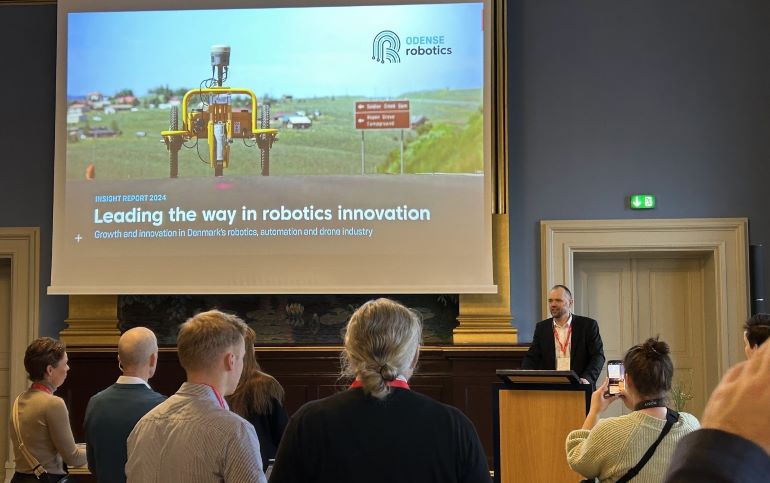|
Listen to this article |

Søren Elmer Kristensen, CEO of Odense Robotics, greets global delegates at R-24. Credit: Eugene Demaitre
ODENSE, Denmark — Last week, the R-24 conference for robots, automation, and drones demonstrated why the city of about 206,000 residents is one of the most vibrant for technology in Europe and the world. The spirit of collaboration, from cobots to corporate partnerships, is key, according to Søren Elmer Kristensen. For the past year, he has been CEO of Odense Robotics.
One of the organizers of the event, Odense Robotics represents about 593 companies across Denmark. The organization works with local and national industry, academia, and the public sector to share insights, accelerate growth, forge partnerships, nurture people, and drive innovation, said Kristensen in an R-24 keynote.
“Collaborative robots, flexible automation, and drones are changing how we live and work,” he said. “We’re looking at agriculture, food, construction, healthcare, logistics, and manufacturing — places used to automation and not so used to it.”
Denmark turns industry decline into an opportunity
Odense’s robotics cluster has its roots in the city’s steel working and shipbuilding industry, explained Rasmus Torpegaard Festersen, investment manager for robotics and drones at Invest in Odense. By the early 1980s, manufacturing had shifted to Asia, and AP Moller – Maersk decided to invest in research into more efficient means of production.
“The shipyard wanted robotic help with welding, and it was the first collaboration between industry and the University of Southern Denmark,” Kristensen told The Robot Report. “Like other cities, we’ve been through tough times, but visionaries from both parties and the municipality recognized the need to shift the paradigm from production to technology innovation.”
Although the shipyard still closed, the investment led to the founding of cobot leader Universal Robots A/S (UR) and Mobile Industrial Robots ApS (MiR), which Boston-based Teradyne Inc. acquired in 2015 and 2018, respectively.
“That really put us on the map globally,” Festersen said. “Talent attracts talent, and we now have a critical mass.”
Not only have UR and MiR grown, with plans to open a collaborative robotics hub in Odense in May, but Denmark is now home to 593 robotics companies, noted Kristensen.
“Our ecosystem also recognized that to grow, we needed to build trust,” he added. “People can freely move, but companies can’t just steal talent from one another. We’re also looking at mentoring more startups in our incubator.”
 Learn from Agility Robotics, Amazon, Disney, Teradyne and many more.
Learn from Agility Robotics, Amazon, Disney, Teradyne and many more.
Insight Report tallies growth
Odense Robotics and its partners also last week released its annual Insight Report, which described the growing sector but also noted challenges. Danish robotics, automation, and drone companies employ 13,700 people in Denmark and 4,800 abroad, reflecting 9% growth in the past year, it said.
In 2022, the cluster had a total turnover of DKK 27.5 billion (€3.7 billion or $4 billion U.S.), of which DKK 13.1 billion (€1.8 billion or $1.9 billion) came from exports, said the report. However, supply chain constraints, market awareness, and global economic hurdles have arisen, acknowledged Kristensen. A survey of more than 300 Danish companies found that:
- 91% face constraints related to limited time, resources, and finances for innovation and product development
- 82% struggle with customer awareness regarding the technologies’ potential benefits
- 81% grapple with a shortage of qualified workforce
- 67% encounter difficulties because of a lack of capital
Still, the Danish robotics cluster expects the creation of 30,000 jobs in the next decade, said Peter Rahbæk Juel, mayor of Odense. He mentioned that two startups had recently relocated from Finland to be part of Odense’s ecosystem.

Peter Rahbæk Juel, the mayor of Odense, Denmark, at the opening of the R-24 conference. Credit: Eugene Demaitre
Odense Robotics continues collaborative approach
“Of our 350 members, 20% were established since 2020, and 87% collaborate with other robotics companies,” said Kristensen. “We’re also working on training and delegation visits with other clusters in Europe and North America, such as Pittsburgh.”
“Denmark punches above its weight,” said Lars Appel Haahr, special advisor to Denmark’s Ministry of Foreign Affairs, which works with Invest in Odense. “It is the most competitive, least corrupt, and has proven resilience with dual-use and digitalized companies.”
From 2015 to 2024, more than €1 billion ($1.09 billion) has been invested in local robotics companies, said the Insight Report. More than 160 robotics organizations are in the vicinity of Odense, making it one of the biggest concentrations in Europe.
The Financial Times recently named the Odense Robotics StartUp Fund as one of Europe’s best startup hubs. The cluster goes through the foreign ministry to work with international partners, and the R-24 conference included delegations from Germany and South Korea.
The Robot Report joined the delegations in visiting the Odense Port, the Danish Technological Institute, and the drone test center at Hans Christian Andersen Airport. More coverage of these and the Investor Summit to come.





